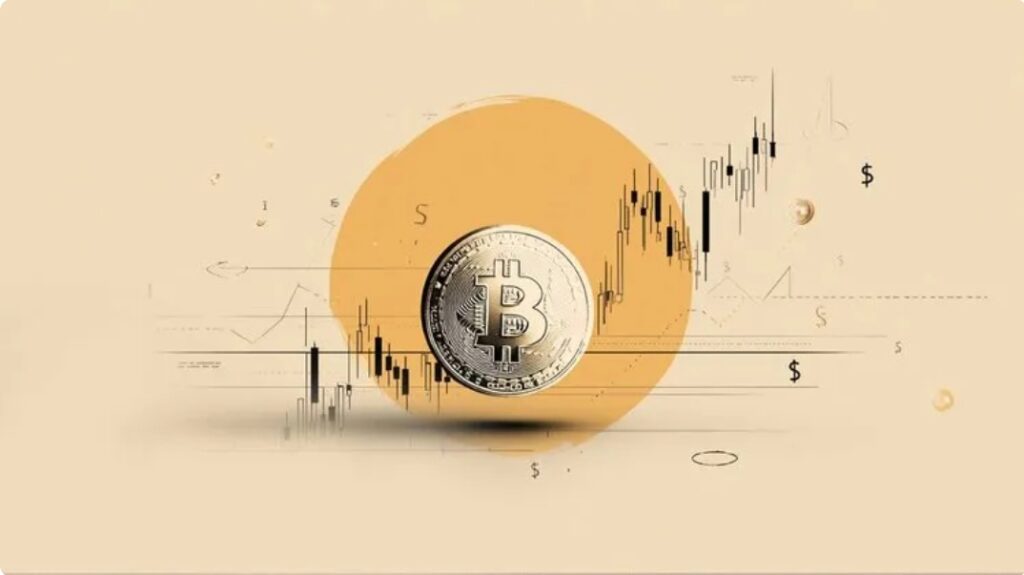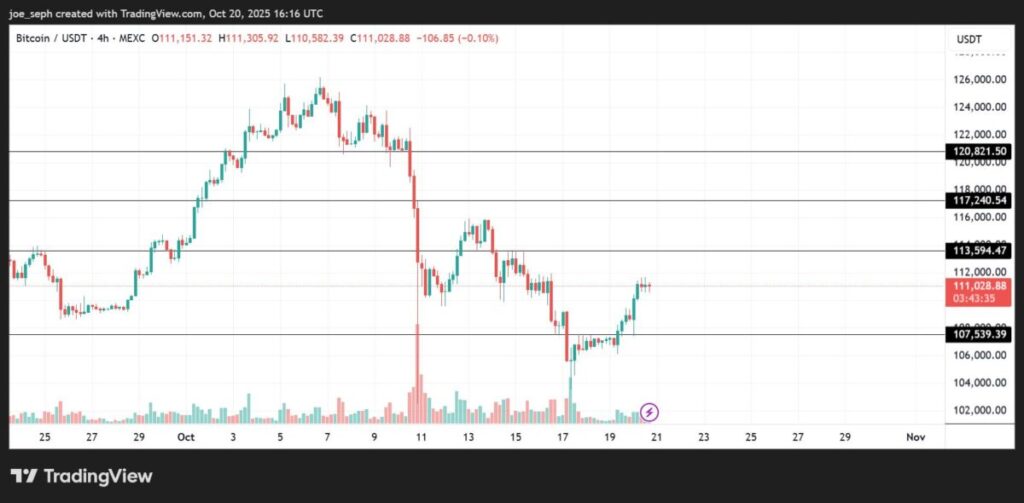
Bitcoin’s recovery from $108,000 to $111,141 on October 20, 2025, marks more than just a technical bounce. It signals that despite October being the worst month since 2015, the groundwork for a potential November surge is already forming. The question isn’t whether Bitcoin can reach $120,000—it’s which catalyst will be the spark.
Right now, three powerful forces are converging that could propel Bitcoin significantly higher in the coming weeks. Understanding these catalysts helps traders and investors position accordingly before the move happens, rather than chasing it after the fact.
1.Catalyst 1: The Federal Reserve’s October 28-29 Rate Cut Is Already 95% Priced In
The most immediate catalyst sitting on the calendar is the Federal Reserve’s FOMC (Federal Open Market Committee) meeting scheduled for October 28-29, 2025. Markets are already 95% confident that the Fed will deliver a 25 basis point (0.25%) rate cut, according to futures pricing.
This matters for Bitcoin because lower interest rates reduce the opportunity cost of holding non-yielding assets. When money becomes cheaper to borrow, investors rotate capital from bonds and cash into alternative assets like Bitcoin. The psychological effect is equally important: rate cuts signal that central banks view economic weakness as a concern, prompting investors to seek hedges against potential monetary stimulus and inflation.
Why This Timing Matters: Bitcoin has historically rallied following Fed rate cuts. In September 2023, when the Fed cut rates for the first time after months of tightening, Bitcoin surged 8% within days. The October 28-29 meeting comes at a critical juncture—after weeks of macro uncertainty and the crypto market’s recent $20 billion liquidation cascade that sent Bitcoin to $108,000.
If the Fed signals dovishness beyond just the single 25 bps cut—perhaps indicating more cuts ahead—Bitcoin could see an accelerated rally. Conversely, if Fed Chair Jerome Powell uses hawkish language suggesting a pause in the cutting cycle, upside momentum could stall. Either way, volatility around this meeting will likely push Bitcoin toward a decision point: either breaking above $113,500 resistance toward $117,000-$120,000, or retesting support at $107,500.
What to Watch: Listen for Powell’s forward guidance on future rate cuts and inflation trajectory. If he signals multiple cuts ahead, expect Bitcoin to attempt a breakout. If he sounds cautious, expect consolidation.
2.Catalyst 2: Institutional Accumulation Is Accelerating, Not Slowing
While Bitcoin ETF outflows hit $366.59 million on Friday (October 17), the broader institutional narrative tells a different story. The cumulative inflows into U.S. Bitcoin spot ETFs remain strong at $61.54 billion, representing 6.75% of Bitcoin’s total market capitalization. This means over $143.93 billion is now held within institutional ETF vehicles—a structural demand floor that didn’t exist three years ago.
More significantly, corporate treasury accumulation is accelerating. Metaplanet, a Japanese investment firm, recently added 5,268 BTC (worth approximately $615 million) to its balance sheet, becoming the world’s fourth-largest corporate Bitcoin holder. MicroStrategy continues its aggressive accumulation strategy, while other public companies globally are following suit. Data shows over 90 publicly traded companies now hold Bitcoin on their balance sheets, representing an aggregate $113 billion in holdings.
Why This Matters for Price Action: Corporate and institutional buyers don’t trade on emotion or short-term volatility. They accumulate through cycles, which creates a bid under the market during pullbacks and removes supply during rallies. When a company like Metaplanet deploys $615 million into Bitcoin, it’s a signal that institutional confidence remains intact despite October’s weakness.
This institutional bid is particularly powerful because it’s structural—these holdings are long-term balance sheet assets, not trading positions. Unlike retail traders who panic-sell during crashes, institutions hold through volatility. This means each major dip becomes an accumulation opportunity for smart money, which then creates support levels that prevent further downside.
The Catalytic Effect: If we see another major corporate announcement of Bitcoin treasury purchases in late October or November, it could re-ignite retail FOMO and accelerate the move from $111K toward $120K. Such announcements typically trigger media coverage and retail investor rush-in, amplifying the initial institutional buying.
What to Watch: Monitor announcements from major companies considering Bitcoin treasury allocation. Any acquisition of 1,000+ BTC by a public company should signal potential for a 2-3% jump in Bitcoin’s price as it creates media narrative and retail follow-through.
3.Catalyst 3: Technical Breakout Setup—The “Rounded Bottom” Pattern and RSI Reversal
From a technical analysis perspective, Bitcoin is displaying a textbook recovery pattern that suggests higher prices ahead. The intraday low of $108,000 on October 20 represents the bottom of what analysts call a “rounded bottom” formation—a bullish reversal pattern that precedes significant upside moves.

The evidence:
- RSI (Relative Strength Index) collapsed to 28 during the low, entering severely oversold territory
- Recovery to $111,141 coincided with RSI climbing to 54, indicating renewed buying momentum without reaching overbought levels
- 4-hour chart shows clean support holding at $107,500
- Moving averages are aligning: the 50-day SMA near $117,801 and 200-day SMA at $110,207 provide progressive resistance levels
When Bitcoin forms a rounded bottom with this type of RSI reversal, historical precedent suggests a move of 8-12% from the low is typical. From $108,000, that would put Bitcoin at $116,640-$121,440—comfortably above the $120,000 target.
The Breakout Zone: Resistance clusters exist at $113,500 and $117,000. A decisive close above $117,000 (on a daily candle) would invalidate the bearish setup and confirm the rounded bottom pattern, triggering automated breakout buying and short squeeze liquidations.
Open Interest as a Signal: Current open interest sits at $152 billion, up 3% from recent lows. This is moderate—not so high that a move would cause cascading liquidations, but high enough that a 5% rally ($111K to $117K) would trigger significant short liquidations, creating additional upside momentum.
What to Watch: If Bitcoin holds above $111,000 and closes above $113,500 on the daily chart, expect momentum to accelerate toward $117,000. Once $117,000 breaks, $120,000 becomes a reasonable target within 7-10 days.
4.How These Three Catalysts Interact
The power of these catalysts comes from their convergence timing:
- Fed rate cut (Oct 28-29) provides macro tailwind that justifies institutional buying
- Corporate accumulation narrative (ongoing announcements) creates retail FOMO and media coverage
- Technical breakout setup (rounded bottom + RSI reversal) gives traders a clean entry pattern to follow
If all three align, Fed cuts rates, a company announces major Bitcoin purchase, and Bitcoin breaks above $117,000, the combination could spark a cascade move toward $120,000 and beyond.
Conversely, if any single catalyst fails (hawkish Fed, no corporate announcements, technical breakdown below $107,500), the move stalls and consolidation continues.
5.Risk Management: What Could Stop This Rally
While the three catalysts present a compelling bullish case, traders should respect downside risks:
- Hawkish Fed surprise: If Powell signals no more rate cuts ahead, risk-off sentiment could return
- U.S.-China tensions: Geopolitical escalation remains a wildcard that could trigger sudden deleveraging
- Macro shock: Unexpected economic data could shift Fed expectations
- Short-term exhaustion: If Bitcoin rallies too quickly from $111K to $118K+, profit-taking could stall the move
The key is to use support and resistance levels as decision points. If $107,500 breaks decisively on a daily close, the bullish thesis is damaged and caution is warranted. If Bitcoin breaks above $117,000, conviction increases and targeting $120,000+ becomes more reasonable.
6.Positioning for the Move
For traders looking to capitalize on these catalysts:
Conservative Approach: Wait for a break above $113,500 on the daily chart before adding long positions. Use limit orders to buy near support zones ($110,000-$111,000) with stops below $107,500. Target profits at $117,000 and $120,000 with partial exits.
Moderate Approach: Scale into positions now with 50% of intended size near $111,000, adding 25% more if Bitcoin breaks above $113,500, and final 25% on a close above $117,000. This averaging-up approach reduces risk while maintaining upside exposure.
Leverage-Based Approach: If using MEXC Futures with leverage, keep position sizing tight and use tight stop-losses (2-3% below entry). Set take-profits at identified resistance levels rather than chasing price. Remember: November’s largest moves often come after October’s washout—stay disciplined to capture them.
The Bottom Line: Timing Matters
Bitcoin’s recovery from $108,000 to $111,141 on October 20 represents more than a bounce—it’s a signal that the bearish setup is exhausted and the technical foundation for a rally is forming. The three catalysts outlined above (Fed rate cut, institutional accumulation, technical breakout) create a compelling case for Bitcoin to reach $120,000 in coming weeks.
The key is monitoring these catalysts as they develop. A Fed rate cut alone might rally Bitcoin 2-3%. A corporate announcement might add another 2-3%. A technical breakout through $117,000 could add another 2-4%. Combined, these catalysts could easily produce the 8% move needed to take Bitcoin from $111K to $120K.
Success in this environment requires patience, position discipline, and clear stop-loss rules. Use MEXC’s advanced trading tools, including take-profit and stop-loss features to define your risk/reward before entering positions. The move to $120,000 is likely coming; the question is whether you’ll be positioned to benefit from it.
Disclaimer:This content is for educational and reference purposes only and does not constitute any investment advice. Digital asset investments carry high risk. Please evaluate carefully and assume full responsibility for your own decisions.
Join MEXC and Get up to $10,000 Bonus!



